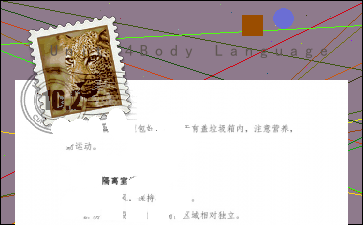Unit 4Body Language
以下为《Unit 4Body Language》的无排版文字预览,完整格式请下载
下载前请仔细阅读文字预览以及下方图片预览。图片预览是什么样的,下载的文档就是什么样的。
Unit 4
Body language
Body Language is a form of non-verbal communication.
It uses movements or positions of our body to show other people what we are thinking or feeling.
It includes body movements, facial expressions, gestures, posture , speaking distance and other non-verbal signals.
What is body language?
speaking
ringing
writing
typing
Spoken
language
Written
language
Body
language
Ways of communicating
gesture
facial expression
action
guess, guess, guess,
gestures
silent stop cry happy
sadness victory handshake kiss shake nod bow blow a kiss anger surprise
come here money well done
I don’t know
silent
I love you.
stop
victory
handshake
Kiss
hug
shake
nod
bow
blow a kiss
joy
anger
surprise
sorrow
Facial expressions
look down upon sb
disappointed
What is the feeling of the baby?
sad
surprised
What are these people communicating?
The mother is
trying to quiet her
crying child.
He is thinking
deeply.
She is feeling
ill .
The policeman is
telling cars to go.
How are they feeling?
happy
confused
Good!
Bad!
Come here!
Me?
I don’t know!
Body language varies from culture to culture.
show interest
rude or
disrespectful
zero
rude
money
OK
No1
rude
great / good job
Can you guess what the following gesture from Japan means?
angry
Can you guess what the following gesture from France means?
I don’t believe you.
What do people in different countries usually do when meeting?
Japan: bow
China, Britain:
handshake
Some western countries: hug
Russia,
France: kiss
Reading
Communication:
No problem?
Predict what you think the topic will be.
Tony Garcia (Columbia)
Julia Smith (Britain)
George Cook (Canada)
Japanese- Akira Nagata
Reading comprehension
I. While reading, please try to divide the whole passage into four parts and match the main idea.
Part 1.
(para. 1)
Part 2
(para. 2 &3 )
Part 3.
(para. 4 )
Part 4.
(para. 5)
The author was sent to Capital
International Airport to meet this
year’s international students.
People from different countries express
greetings in different ways.
Different people have different
body languages.
Summary of body language.
First-reading
II. How do different international
students behave when they greet people?
Complete the chart with information
from the passage.
man from Colombia
kiss on the cheek
Julia Smith
woman from Britain
everyone
Akira Nagata
bowing
everyone
man from Canada
shaking hands
everyone
Ahmed Aziz
man from Jordan
shaking hands nodding
Darlene Coulon
woman from France
people she knows
Read the passage again and then answer the following questions.
Second-reading
A. Two university students meet the
international students in the airport.
B. Men and women use different body
languages in foreign countries.
C. Different cultures have different body
languages.
D. There are different kinds of cultures in
the world.
1. What does the text mainly talk about?
2. What can we infer from the text?
A. A boy from Spain is likely to touch
the people he meets.
B. Physical distance can’t send out a
message.
C. English people may stand very close
to their friends.
D. It’s friendly to touch Muslim women.
3. From the passage we know, most
international students greet others by ______.
A. shaking hands
B. bowing
C. kissing
D. touching shoulders
4. When writing the text, the author is
A. encouraging readers to do
something
B. informing readers of something
C. drawing readers attention to some
western countries
D. regretting cultural difference
Fill in the blanks
The first person who arrives is Mr. Garcia from Columbia, closely _________ by Julia Smith from Britain. When they are introduced to each other, Mr.Garcia approaches Ms Smith, _______ her shoulder and _______ her on the cheek . Ms Smith steps back appearing surprised. The visitor
from Japan comes in smiling at the same time as George Cook from Canada. As they are introduced, Mr. Cook _______ his hand out to the Japanese who ______ . His nose touches Mr. Cook’s moving hand, and they both _________.
followed
touches
kisses
reaches
bows
apologize
These are examples of learned or cultural “body language”. Not all cultures ________ each other the same way, nor are they comfortable touching _________ or being too close or too far away. In the same way that people __________ with spoken language, they also __________ their feelings using unspoken “language” through keeping physical distance, actions or _________.
express
communicate
strangers
greet
posture
Summary :
Body language varies from culture to culture. Not all members of all cultures behave the same way. We should try to grasp and respect each other’s culture in order to make good communication.
1.Summarize what you have learnt in this period.
2.Remember the new words and phrases.
Homework[全文已结束,注意以上仅为全文的文字预览,不包含图片和表格以及排版]
以上为《Unit 4Body Language》的无排版文字预览,完整格式请下载
下载前请仔细阅读上面文字预览以及下方图片预览。图片预览是什么样的,下载的文档就是什么样的。
图片预览
热门关注
- Halloween
- Book5 Unit1
- Travelling abroad
- 必修一unit2 Reading
- M1U5 Nelson Mandela
- M8U1warming up & Reading
- unit2 English around the world
- Unit 12 Visting Britain 终结版
- 教学设计
- 人教版高中英语 必修一 Unit5 《 Nelson Mandela ---a modern h
- Unit1 Section A (1a-2d)(完整版)
- -Unit-colors-and-mood
- 李 波 unit5Using
- coutch potatoes
- 评优课教案2
- zuowen
- Reading--吕某某
- 选修8 unit4 Pygmalion
- Unit1 Section A (1a-2d)(完整版)
- 必修5第一单元
相关下载
- Halloween
- Book5 Unit1
- Travelling abroad
- 必修一unit2 Reading
- M1U5 Nelson Mandela
- M8U1warming up & Reading
- unit2 English around the world
- Unit 12 Visting Britain 终结版
- 教学设计
- 人教版高中英语 必修一 Unit5 《 Nelson Mandela ---a modern h
- Unit1 Section A (1a-2d)(完整版)
- -Unit-colors-and-mood
- 李 波 unit5Using
- coutch potatoes
- 评优课教案2
- zuowen
- Reading--吕某某
- 选修8 unit4 Pygmalion
- Unit1 Section A (1a-2d)(完整版)
- 必修5第一单元
